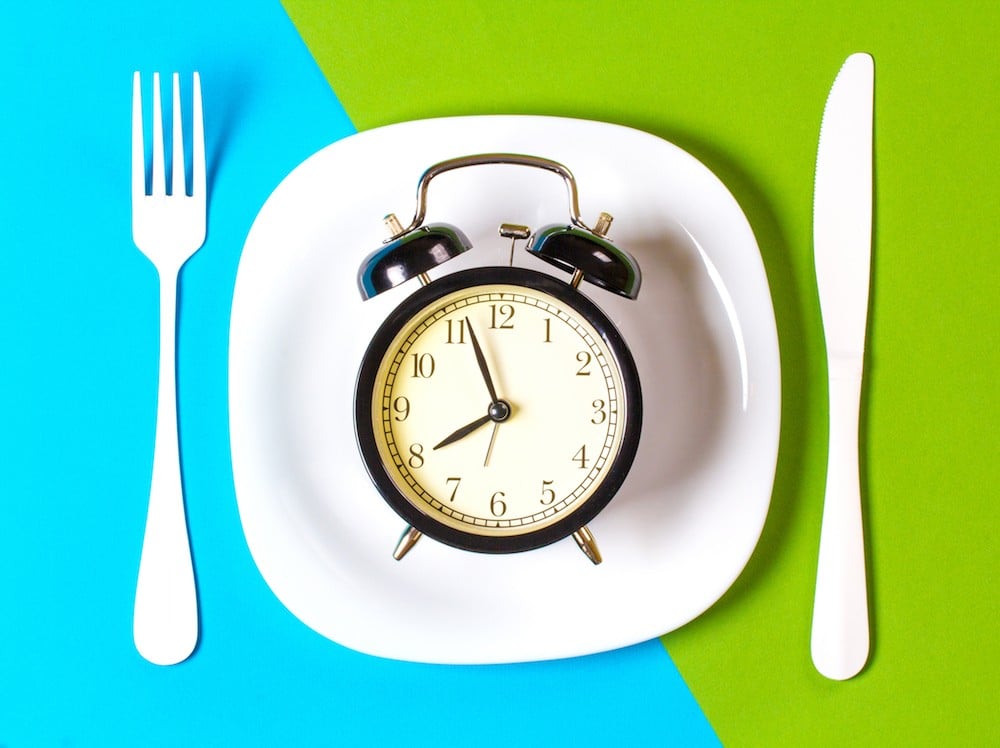Fasting is one of the oldest healing — and religious — practices in human history, Yet, despite its origin, it’s never been more popular that it is today. Intermittent fasting, in particular, has seen a spike in popularity with celebrities and health experts gushing by intermittent fasting results. In fact, the diet has become so popular that one could argue it’s the new Whole 30 — only it’s less about food restrictions and more about time.
So, what is intermittent fasting? In short, it’s an umbrella term used to describe a practice of fasting and non-fasting. However, it’s also so much more than that. Ahead, we take a deep dive into the world of fasting — benefits, methods, and results — and find out what happened when one writer gave the diet a try.

What is intermittent fasting
As we mentioned previously, intermittent fasting is a broad term used to describe a variety of diet methods that include fasting and non-fasting. However, it’s most often used to describe time-restricted eating. Time-restricted is much more liberal — and, to be honest, bearable — than whole-day fasting, however, it can take some getting used to.
Methods
In a nutshell, time-restricted fasting involves fasting for 16 hours and non-fasting for eight hours each day. That said, many devotees also swear by a 12-14 hour fast and 10-12 hour eating period for similar intermittent fasting results.
Whole-day fasting is also considered intermittent fasting and usually consists of regular one-day fasts. Also known as the 5:2 diet, whole-day fasting involves five non-fasting days and two fasting days. However, those practicing the method are allowed to eat 500-600 calories on fasting days. Notably, Jimmy Kimmel is a big fan of this intermittent fasting method. “On Monday and Thursday, I eat fewer than 500 calories a day, then I eat like a pig for the other five days,” he told Men’s Journal. “You ‘surprise’ the body, keep it guessing,” he added. Kimmel reportedly lost 25 pounds after adopting the 5:2 diet.
Benefits
As far as intermittent fasting benefits are concerned, weight loss is one of the biggest reasons so many have converted to the restricting diet. However, that’s not the most exciting benefit. Discover some of the health benefits of intermittent fasting, below.
Improves human growth hormone levels
In many cases, “high” anything can be dangerous regarding health. However, a higher level of human growth hormones can do the body some good. Notably, human growth hormones can help with fat burning and muscle gain.
Promotes cellular repair
In addition to a human growth hormone boost, intermittent fasting can also help cellular repair., which is essential for removing waste from the body’s cells.
Reduce insulin resistance
Intermittent fasting might also benefit those with high levels of insulin resistance, as it lowers blood sugar. Insulin resistance is linked to type 2 Diabetes, so reducing resistance can help lower the risk.
Targets inflammation and oxidative stress
Another reason to try intermittent fasting? It can reduce inflammation and oxidative stress in the body. Oxidative stress causes aging within the body. Both oxidative stress and inflammation influence chance of chronic disease and intermittent fasting helps to reduce both.

What happened when I tried intermittent fasting
As someone who is typically hungry first thing in the morning, I did not think intermittent fasting was for me. After all, even if I stuck to a 14-hour fasting 10-hour non-fasting window (with fasting beginning at 8:00 p.m.), I would still have to wait until 10:00 a.m. to eat every day. No thanks! That said, after researching the perceived benefits of intermittent fasting and reading rave review after another, I thought: “what do I have to lose?” Little did I know, I would lose some belly bloat around my waist — and gain a whole new perspective about food.
When it comes to dieting, I always fail miserably — I have zero control and one cheat day quickly turns into a cheat week. That said, my experience with intermittent fasting looked a lot different than other diets I’ve tried in the past (here’s looking at you, Whole 30). For the most part, I eat relatively healthy — except for a major sweet tooth — so food-wise, I didn’t change much about my diet. I did, however, swear off bagels which, if I’m being honest, probably boosted my results.
Before starting my fasting journey, I set myself up for success by downloading a fasting tracker app called Zero (there really is an app for everything, guys). What I love about the app is you can set your daily fasting goal — mine was 14 hours — and it will remind you when it’s time to eat or start fasting again. Your only commitment? Remembering to check in and click the button to start or stop your fast — easy peasy!
Results
The first few days were hard, and I found it difficult to focus on anything other than food. But, like with any new diet, as the days went on the fasting period got easier and easier.
My belly bloat subsided
While I didn’t experience significant weight loss — those that do typically practice intermittent fasting for months or years — I did notice a difference in my waistline. Prior to intermittent fasting, I experienced a lot of bloat throughout the day. I would sometimes chalk it up to all the water I drink, but deep down I knew it probably had something to do with what I was eating. Intermittent fasting gave me more time to think about the food that I put in my body and, as a result, helped me make healthier choices. That mixed with its ability to ward off inflammation resulted in less bloat.
My eating habits changed
In addition, I also became more aware of my eating habits. Before intermittent fasting, I would roam into the kitchen periodically throughout the day and snack. Little did I know, I was only doing that out of boredom (or habit). Practicing a 14 hour fast helped me better recognize when I needed to fuel my body and when I just needed to take a break and focus on something else for a few minutes.
My productivity improved
Taking a break not only helped my eating habits but my productivity, too. Instead of rummaging through the fridge mid-workday, I found myself doing a load of laundry, cleaning my bedroom, or going on a grocery run. These small tasks not only helped me reset my mind, but they also helped free up time some of my weekend (and evening) time.
Check out The Cheat Sheet on Facebook!
Source: Read Full Article